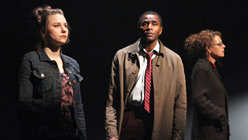Magic Theatre artistic director Loretta Greco says in her program note for Terminus that she’s been trying to secure the rights for the American premiere of Irish writer Mark O’Rowe’s play for five years, basically since she took over the theater’s helm. (O’Rowe’s Howie the Rookie played the Magic in 2000.) It’s easy to see why she had to have it. Terminus is a spellbinding, dizzying show in which it doesn’t matter a whit that it’s made up of three people standing around telling their stories.
These tag-team monologues have a great deal of humor in them, but the tales they tell are often gruesome and gut-wrenching. Still, by the time they’ve reached their worst you’re so hooked that you’ll gladly go with your nameless narrators no matter what dark corners they lead you into. You can guess from the start that these three separate tales will link with each other somehow, but when the connections come they’re in ways you couldn’t possibly have imagined.

A fortysomething woman working at an abuse hotline receives a call from a voice she recognizes as a former student of hers who’s desperate to get an abortion at nine months pregnant. Having failed to help her, she feels she has to go find her. A young woman in her twenties feels the stirrings of attraction for the first time in years, taking her on a dangerous excursion into a construction site. A painfully shy man picks up a plain, attainable-looking woman in a dance club and goes home with her, trying to steer clear of the jeering young thugs hanging around. These humble beginnings quickly take the characters into shocking, sublime, and excruciating journeys that are full of brilliant surprises.
The atmosphere is eerie in the Magic staging by director Jon Tracy, whose company debut with Linda McLean’s equally intense Any Given Day was the highlight of the theater’s last season. Robert Brill’s set is just a large bed of dark gravel that the three characters stand and sit in, Gabe Maxson’s lights kept low and tight around the storytellers, and the air thick with stage fog. It’s a kind of purgatory, to be sure, but what kind has yet to be discovered. The play begins with a deep, bone-shaking rumbling from sound designer Sara Huddleston, in pitch darkness. The intensity never lets up after that, although from then on it’s carried by the performers’ voices and intense presence.




